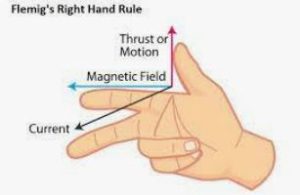Fleming’s right-hand rule is a mnemonic device used in electromagnetism to determine the direction of the force acting on a current-carrying conductor placed in a magnetic field. It is named after the British physicist John Ambrose Fleming.
The rule states that if you stretch out your right hand and orient it in a specific way, with the thumb, index finger, and middle finger at right angles to each other, you can determine the relationships between the three vectors: magnetic field (B), current (I), and force (F).

Here is how Fleming’s right-hand rule is applied:
- Thumb: Point your right thumb in the direction of the current (I), which is the direction of the flow of positive charges.
- Index finger: Extend your right index finger in the direction of the magnetic field (B). The magnetic field can be represented by the magnetic field lines or the north-to-south pole direction of a magnet.
- Middle finger: Your right middle finger will indicate the direction of the force (F) acting on the conductor. It will point perpendicular to both the thumb (I) and the index finger (B).
In summary:
- Thumb represents the current (I).
- Index finger represents the magnetic field (B).
- Middle finger represents the force (F).

Using this rule, you can determine the direction of the force experienced by a current-carrying conductor when placed in a magnetic field. The rule is widely used in understanding and analyzing the behavior of electric motors, generators, and other electromagnetic devices.
Importance of Flemings Right Hand Rule
Fleming’s right-hand rule is important in electromagnetism and has several key applications:
- Determining the direction of force: One of the primary uses of Fleming’s right-hand rule is to determine the direction of the force experienced by a current-carrying conductor in a magnetic field. By applying the rule, you can quickly determine the direction in which the force acts, which is crucial in understanding and designing electromagnetic devices.
- Designing electric motors and generators: Fleming’s right-hand rule helps in the design and operation of electric motors and generators. It enables engineers to determine the direction of the force on the conductor, which in turn determines the direction of rotation or generation of electrical energy. This rule is essential for ensuring the proper functioning and efficiency of these devices.
- Understanding electromagnetic induction: Fleming’s right-hand rule is also used to understand electromagnetic induction, which is the process of generating an electromotive force (EMF) in a conductor when it is exposed to a changing magnetic field. By applying the rule, you can determine the direction of the induced current or the direction of the induced EMF.
- Solenoids and electromagnets: Fleming’s right-hand rule is valuable in understanding and working with solenoids and electromagnets. It helps determine the polarity and direction of the magnetic field produced by a current-carrying solenoid or electromagnet, aiding in their design and application.
- Electrical and electronic circuit analysis: Fleming’s right-hand rule is useful in analyzing electrical and electronic circuits involving magnetic fields. It helps determine the direction of forces or currents induced in nearby conductors or components due to the presence of a magnetic field, assisting in circuit design, troubleshooting, and predicting circuit behavior.
Overall, Fleming’s right-hand rule is a fundamental tool in electromagnetism that provides a simple and intuitive way to determine the relationships between current, magnetic fields, and forces. Its applications range from designing and operating electromagnetic devices to analyzing electrical circuits and understanding electromagnetic phenomena.




